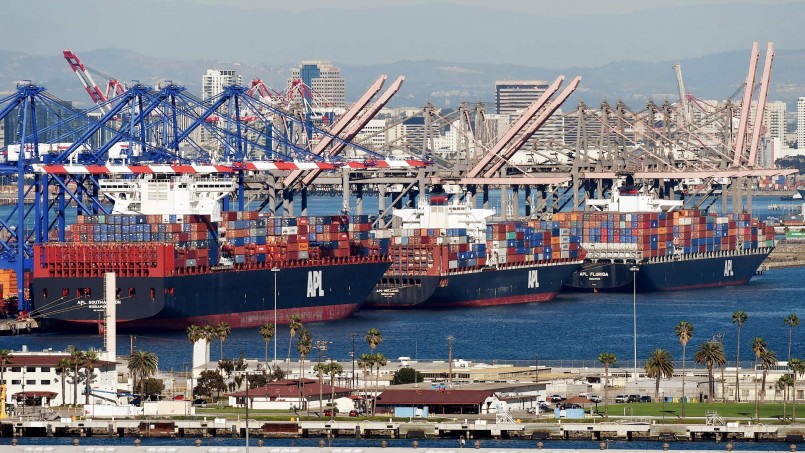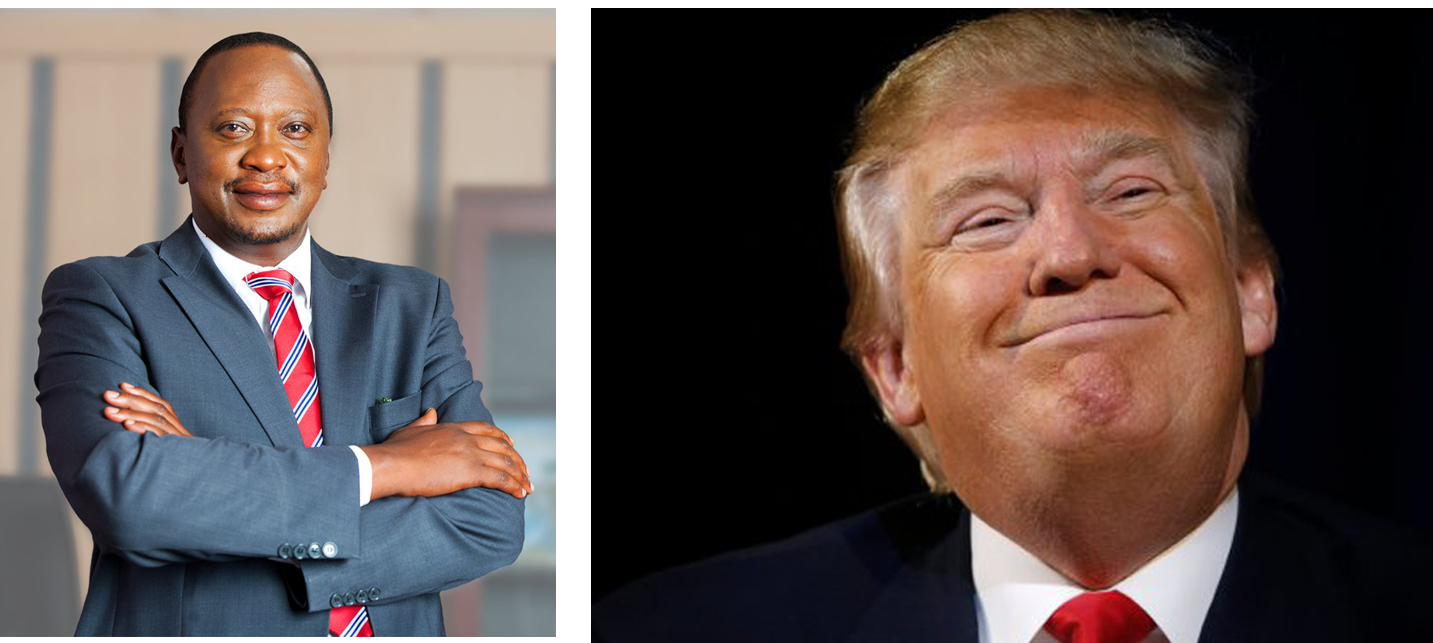By TZ Business News Staff and Agencies.
The controversial US President Donald Trump has picked Kenya in the East African region to partner in trade and the fight against terrorism.
The American Associated Press news agency reported on Tuesday, 7 March, 2017, the US President held a one hour long telephone conversation with the Kenyan President Uhuru Kenyatta in which the two presidents talked trade relations and the fight against terrorism.
The White House said Trump and Kenyatta discussed ways to boost trade between their countries, as well as investment in Kenya and the broader East Africa region. But the analytical US website Stratfor has described Trump’s approach to international trade as ‘disruptive.’
During election campaigns in the US, Mr. Trump described Africans as lazy and spoke against reliance on imports. Press reports quoted him as saying “[Africans] are people who import everything including Matchsticks. In my opinion, most of those African Countries ought to be re-colonized again for another 100 years because they know nothing about Leadership and Self-governance!! “
Mr. Trump even made reference to Kenya during the campaigns, according to media reports: “African Americans are very lazy, the best they do is gallivanting around ghettos, lamenting how they are discriminated. Those are people America don’t need, they are enemies of progress.
“Look African Countries like Kenya for instance, those people are stealing from their own Government and go to invest the money in Foreign Government. From the Government to the Opposition, they only qualify to be used as case study, whenever bad examples are required.”
On Tuesday, 7 March, 2017, the White House Press Secretary Sean Spicer said Presidents Trump and Kenyatta discussed economic partnership and mutual dedication to overcoming terrorism and other regional security challenges through close cooperation.
“President Trump expressed appreciation for Kenya’s significant contributions to the African Union Mission in Somalia and recognized Kenyan troops’ sacrifices in the fight against al-Shabaab,” he said.
The two leaders also discussed ways to boost bilateral trade and investment in Kenya and the broader East Africa region in the hour-long conversation. This was the fifth time Trump has spoken to any African leader since he was sworn in as President on January 20, according to other media reports.
The other Presidents he has spoken to include Abdel Fattah el-Sissi (Egypt), Beji Caid Essebsi (Tunisia), Jacob Zuma (South Africa), and Muhhamadu Buhari (Nigeria).
In February Trump spoke with South African President Jacob Zuma about trade ties and stability in Africa. Zuma’s office said in a statement that the two leaders talked on the telephone reaffirming their commitment to building the “already strong” relationship between their nations.
But Trump’s approach to trade is disruptive according to analysts at Stratfor. A shift in U.S. trade policy that follows the outline presented to Congress would upend the foundations of global trade as it is currently conducted, the analysts contend.

Under its trade agenda outlined Wednesday, the Trump administration asserted that the United States can use its sovereignty to bypass decisions made by the World Trade Organization to settle disputes. (MARK RALSTON/AFP/Getty Images)
The biggest change in the approach that the administration of President Donald Trump may take is its assertion that U.S. sovereignty in trade disputes could empower it to supersede rulings made by the World Trade Organization (WTO).
At its core, the Trump trade agenda aims to return the United States to the forefront of the global system while supporting growth in the domestic jobs market. Specifically, according to a leaked copy of the report, it “reject[s] the notion that the United States can strengthen its geopolitical position by adopting trade measures” that make U.S. industries weaker globally.
This represents a repudiation of the strategy pursued under President Barack Obama in which the pursuit of multilateral trade agreements such as the Trans-Pacific Partnership (TPP) was as much about achieving regional political goals as solely economic ones. But despite its rejection of some existing norms, many of the policies that the new agenda prescribes are not that different from those pursued by previous administrations.
The objective of the Trump administration’s initial Trade Policy Agenda, a document that the Office of the U.S. Trade Representative is required to submit annually to lawmakers, does not appear to be to work against trade or institute an entirely protectionist stance.
The U.S. trade representative has not even been confirmed yet, so U.S. trade policy is fickle at the moment. But the document reflects the thinking of the Trump administration that the existing framework for global trade negotiations and the trend toward multilateral trade deals are inadequate. The Trump team wants to achieve its trade goals through bilateral negotiations where it can protect its own interests — while also compelling other countries to change their policies. Its approach is centered along four major policy directions:
- “Strictly enforce U.S. trade laws.”
- “Use all possible sources of leverage to encourage other countries to open their markets to U.S. exports of goods and services while protecting U.S. intellectual property rights.”
- “Negotiate new and better trade deals with countries in key markets around the world.”
- “Defend U.S. national sovereignty over trade policy.”
The first three points do not represent much of a shift from trade policies under Obama. Since the WTO was founded, the United States has aggressively used its framework to prosecute trade grievances. It has also tried to impel foreign markets to open up to U.S. exports. And although the Obama administration faced criticism for its pursuit of the TPP, it was one of the most advanced trade deals in terms of the number of issues that it attempted to address.
Where Trump’s approach differs the most is the assertion that the United States is not bound by its WTO commitments, nor is it compelled to comply with the group’s decisions on trade disputes. By reasserting its national sovereignty, the United States wants to take the final decision-making process on trade disputes out of the hands of the WTO.
At its most basic, the WTO can be reduced to two key agreements. First, it is an international set of standards on trade protocols that includes the concept of Most Favored Nation status, reducing trade barriers and tariffs. Second, it includes a mechanism intended to resolve disputes between two parties. It is quite clear that the Trump administration values the first accord. It does not want to break apart the WTO, causing trade barriers to rise and conflicting with its objective of opening markets for U.S. exports.
On the other hand, it is clear — despite White House press secretary Sean Spicer’s denial that Washington would not ignore WTO rulings — that the Trump administration feels that the WTO’s dispute settlement mechanism is lacking.
It has reportedly tasked the United States trade representative to find a way to legally file trade cases outside the WTO framework rather than submit them to the group’s arbitration process. This would represent a fundamental shift in the U.S. approach. While the administration may initially decide to file a dispute related to a sector of the economy under the WTO, whose mechanisms are well suited to settle such arguments, it could then choose to ignore an unfavorable ruling in favor of using U.S. law. For example, if Trump’s trade team argues that China is unfairly subsidizing steel exporters, the United States still would likely file the dispute with the WTO. If, however, the WTO dispute panel were to rule against the U.S. argument, Trump’s policy might be to punish China under U.S. laws on trade enforcement regardless.
If the United States chooses that path, it certainly would weaken the WTO’s power, inspiring other countries to ignore its rulings as well. Countries with which the United States has large trade deficits, including China, Mexico, Germany, Japan, Ireland and South Korea, could be the targets of such maneuvers. That could lead them to follow a similar path: First weighing whether to bring a case against the United State in the WTO, then deciding whether to fall back on their own trade laws if Washington did not comply with its decision.
But there could be a hesitation among those countries to bypass the WTO or to bring about significant challenges to the United States in a broad way in the WTO. A fundamental tenet of the WTO is trust and belief in the system among its members, a valuable commodity among trading partners. Though each of the countries in question has a sizable trade surplus with the United States, it does not represent the biggest overall trade partner of any, with the exception of Mexico. Germany’s main market, for example, is the European Union. This would lead to hesitance among U.S. trading partners to bring a significant case against it outside the WTO; retaliatory cases could cause trade disruptions to the tune of nearly $400 billion (in the event that they challenge the proposed U.S. import tax).
Such a series of disputes could bring the entire concept of the WTO into question in the eyes of the United States. And U.S. trading partners simply cannot risk undermining global confidence in the WTO as a ruling framework, given their dependence on trade outside the United States. Instead, China, Germany and others are likely to challenge the United States along the margins in key industries to achieve certain goals and pressure Washington as best they can without risking the WTO framework itself.
In pursuing a policy of U.S. trade sovereignty, the Trump administration hopes that it can push countries to settle disputes with the United States outside of the WTO framework. To achieve his goals, Trump is betting that others will be willing to put the United States at the center of the global trade order and adhere to its view of the WTO as a guiding principle, not a final arbiter, calculating that no one wants to risk jeopardizing the organization. “Trump’s Disruptive Approach to Trade” is republished with permission of Stratfor.




